|
Modification
|
Molecular Structure
|
Duplex Stability
|
Nulease Resistance
|
Chemical Characteristics
|
|
Phosphorothioate
|
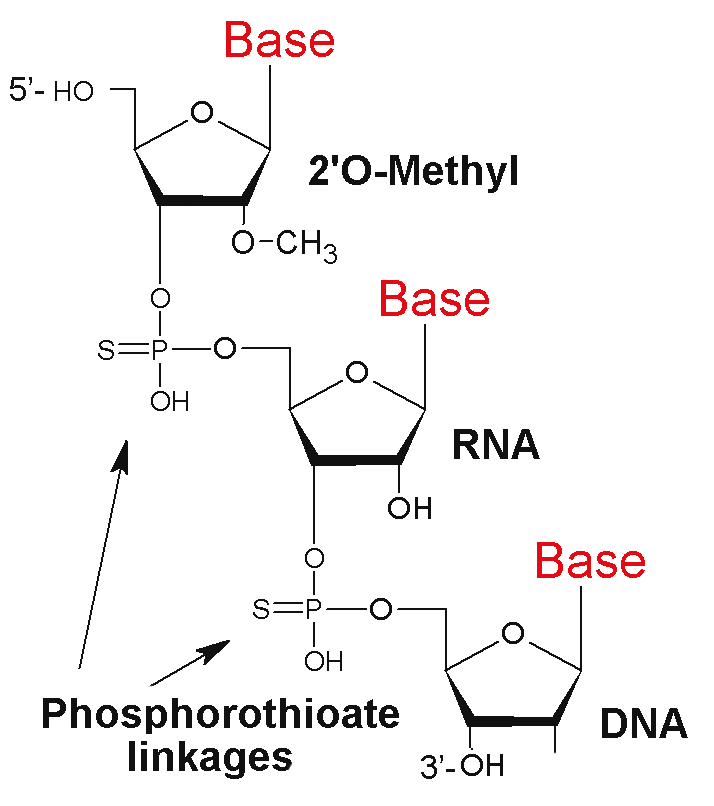
|
Hybridizes to the target sequences with lesser affinity than oligos with phosphodiester backbone
|
Imparts resistance to nuclease degradation
|
Modification of the phosphodiester bond by replacing one of the non-bridging oxygens by sulfur
|
|
Propyne Analogs
|
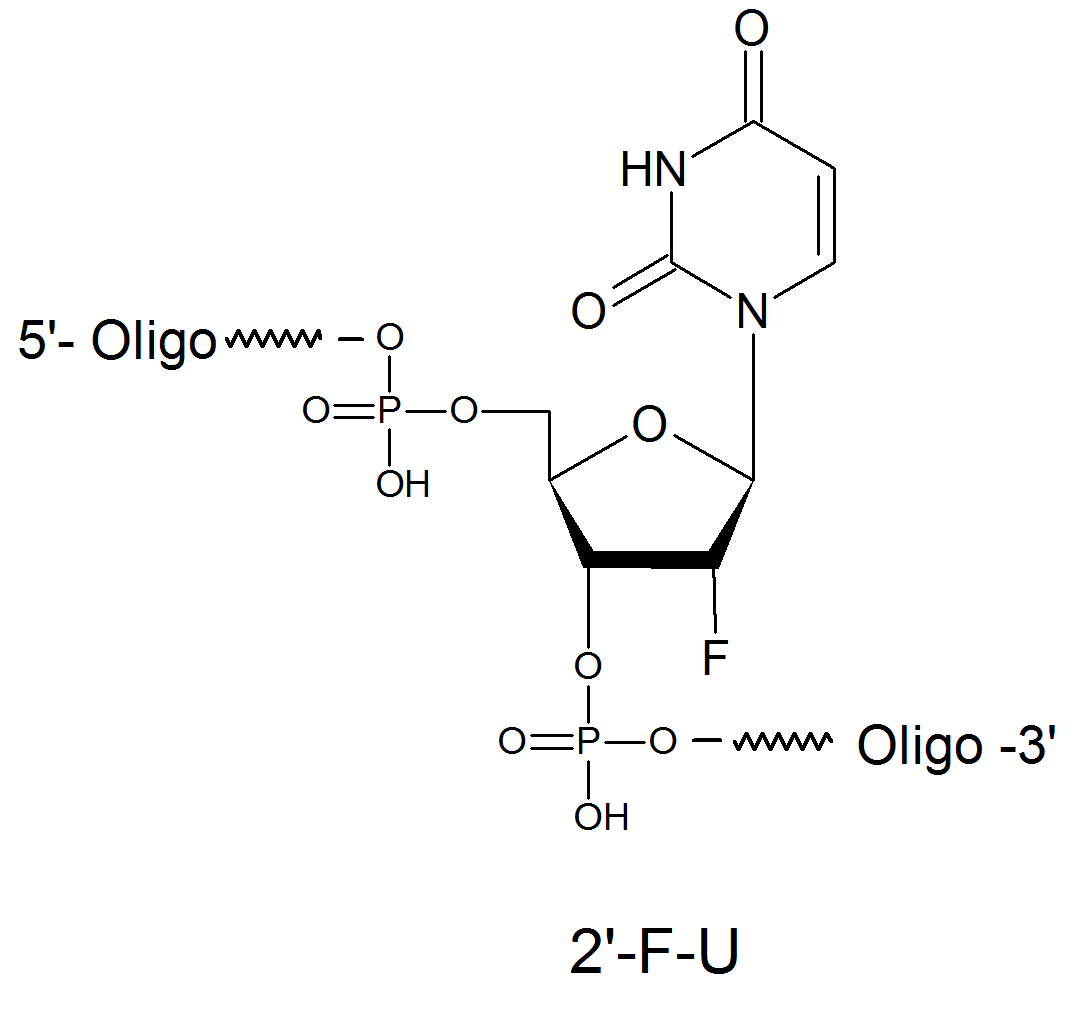
|
Increased binding affinity to the target sequence and increased stability
|
Increased nuclease resistance
|
C-5 propyne analogs of dC and dT
|
|
|
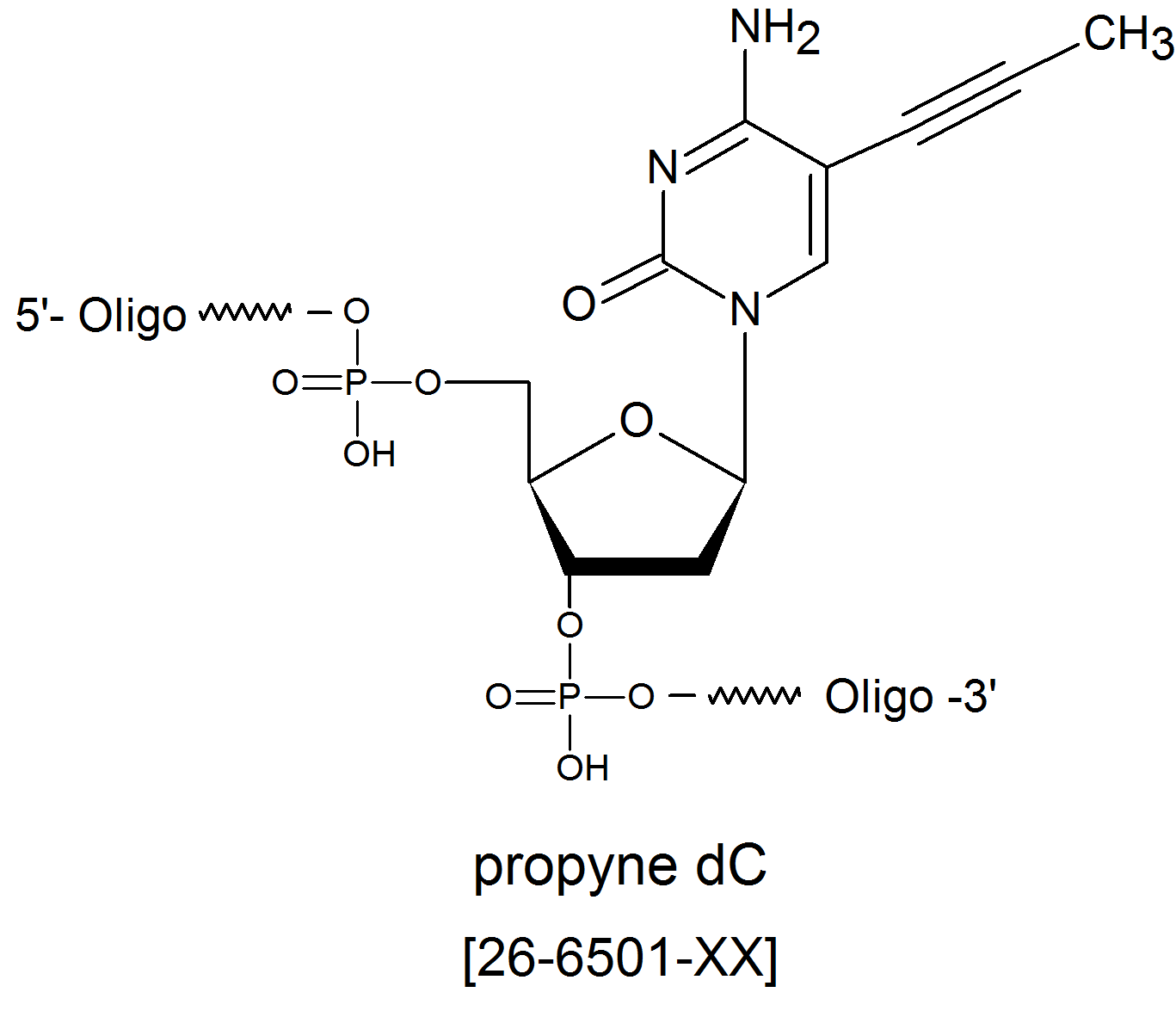
|
|
|
|
|
2'-O methyl RNA
|
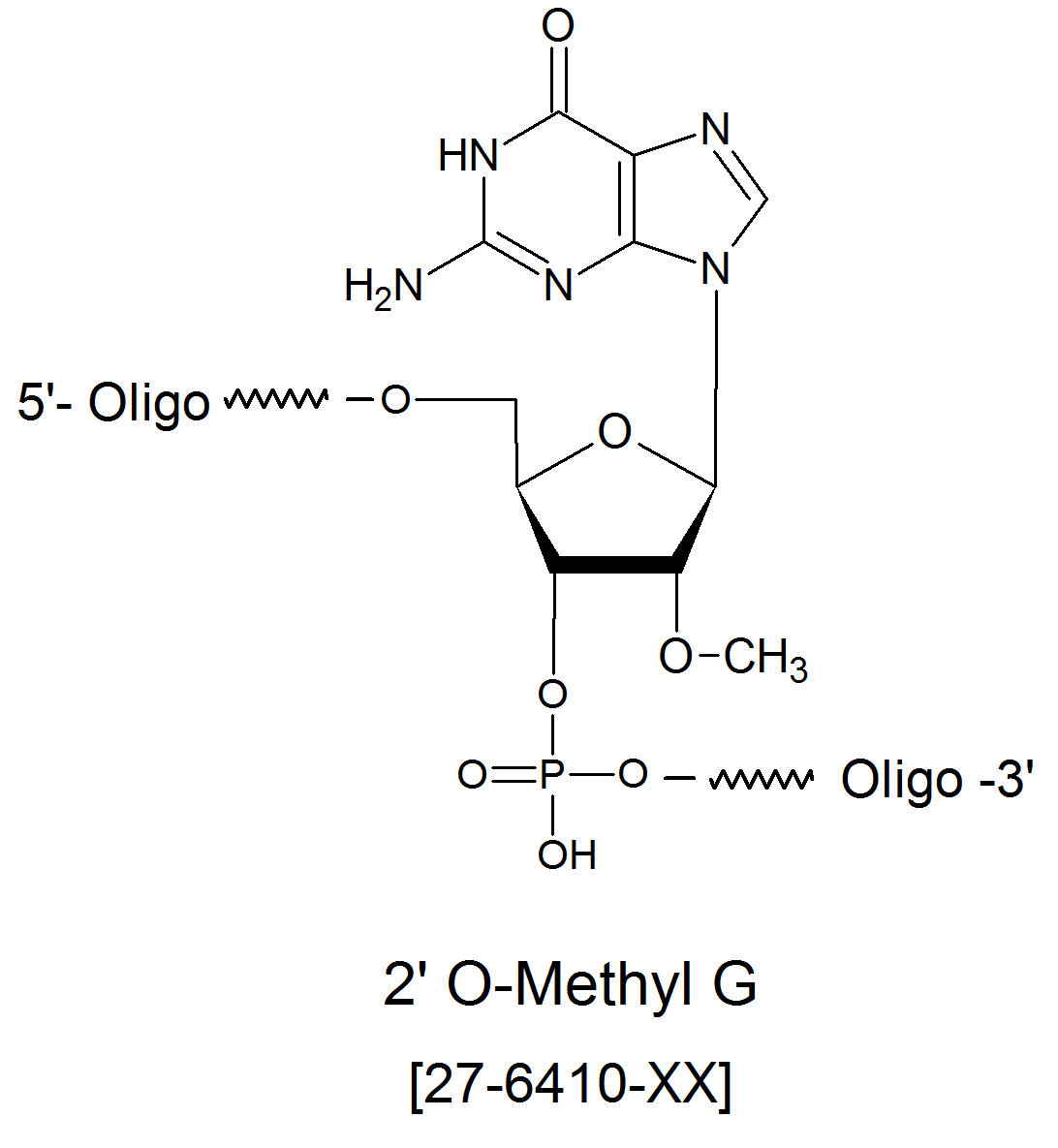
|
Binding similar to DNA bases
|
Increased
|
2'O-methyl at the 2' hydroxyl position
|
|
5-me-dC
|
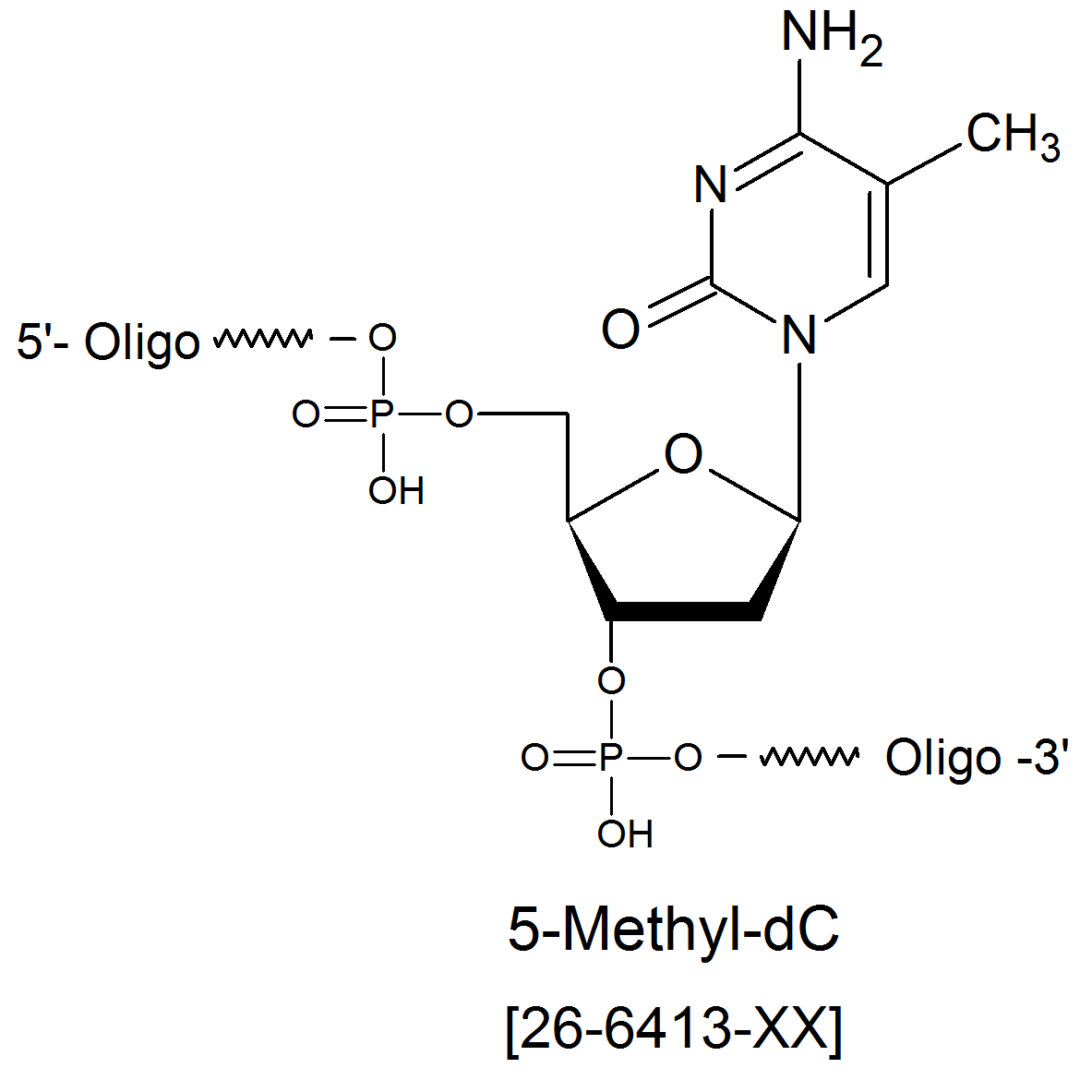
|
Increased
|
Similar to DNA
|
C-5 methylated dC
|
|
2-Amino dA
|
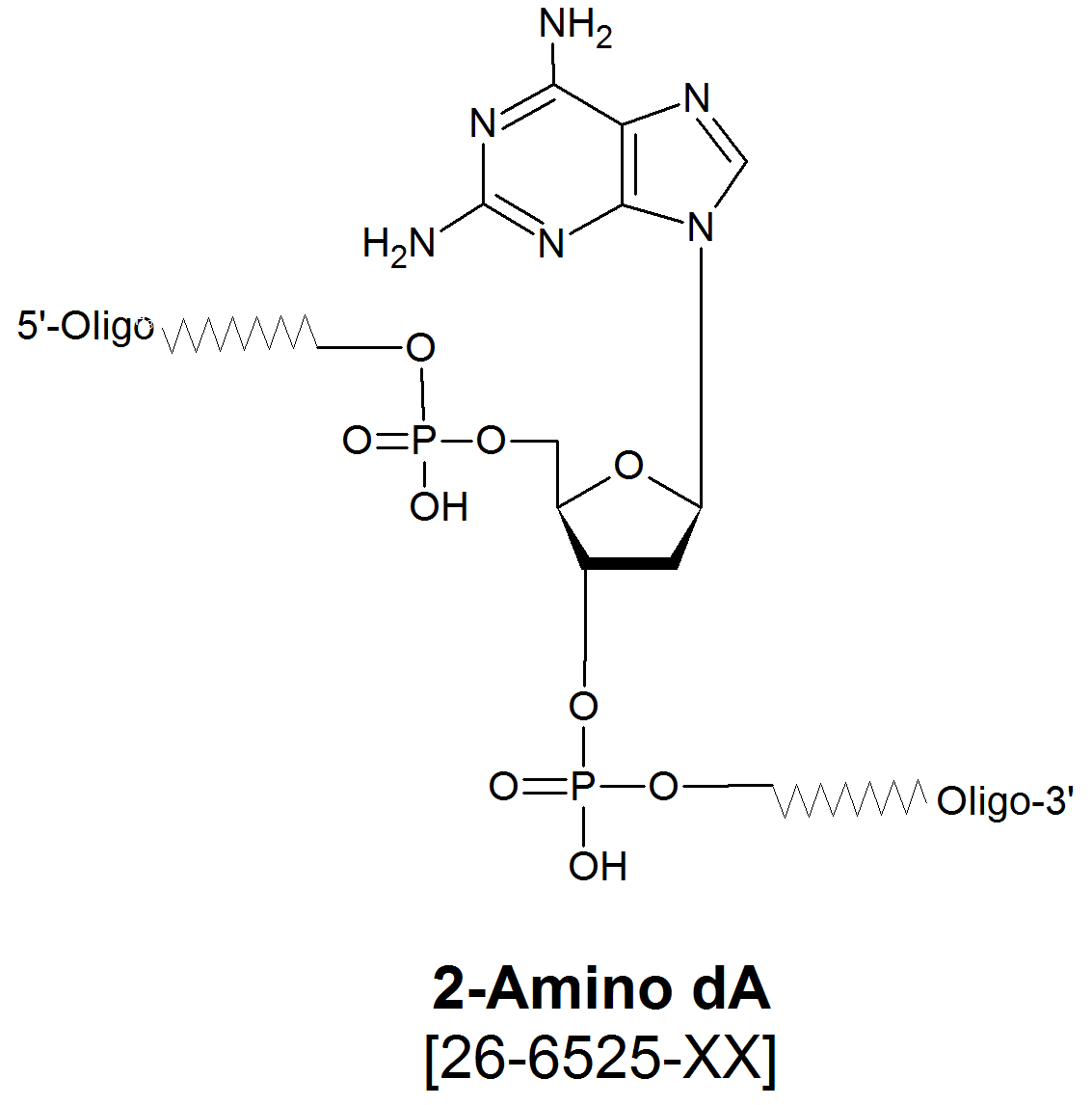
|
Increased
|
Similar to DNA
|
2-Amino dA
|
|
2'-F bases
|
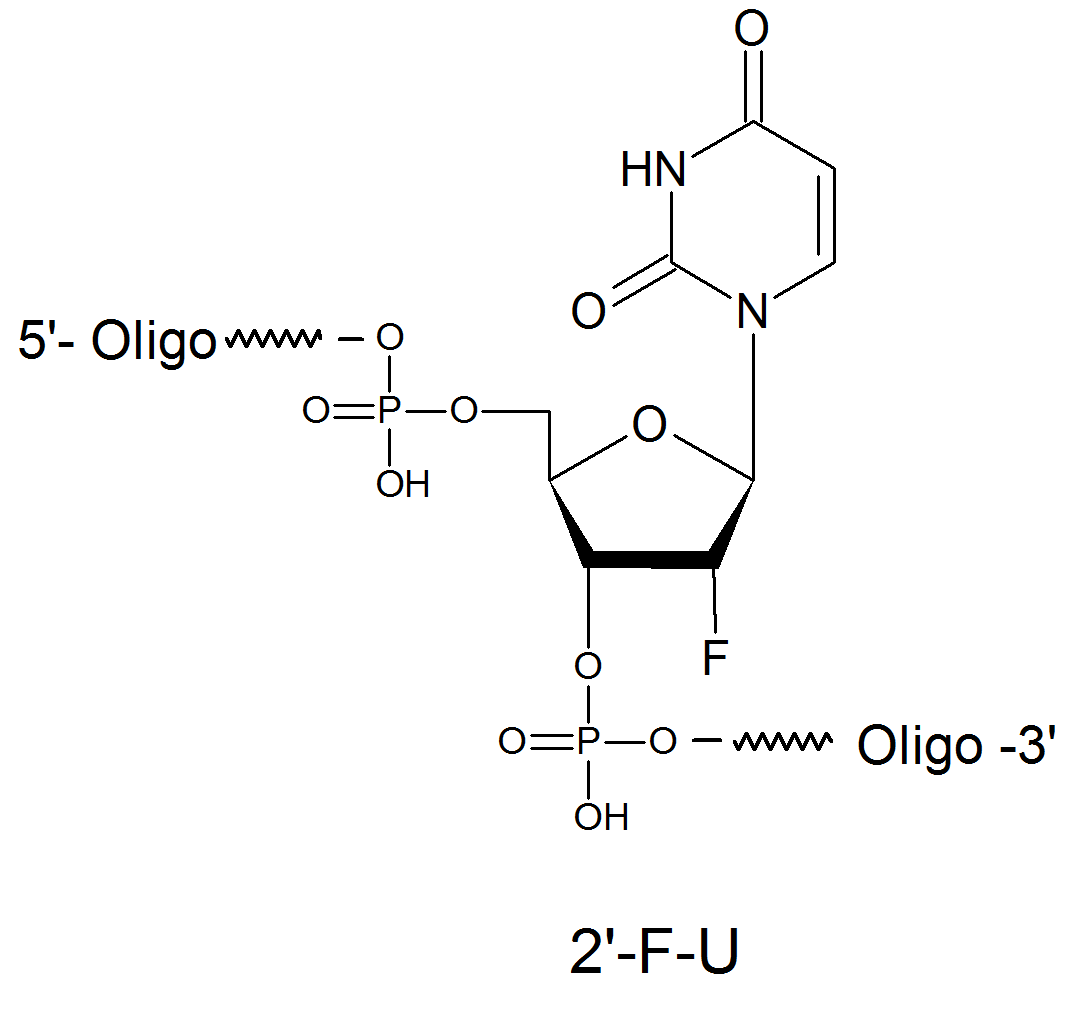
|
Increased
|
Substantially increased
|
Fluoro at the 2' position
|
|
2'-F bases
|

|
Increased
|
Substantially increased
|
Fluoro at the 2' position
|
|
2'-5' linked oligos
|
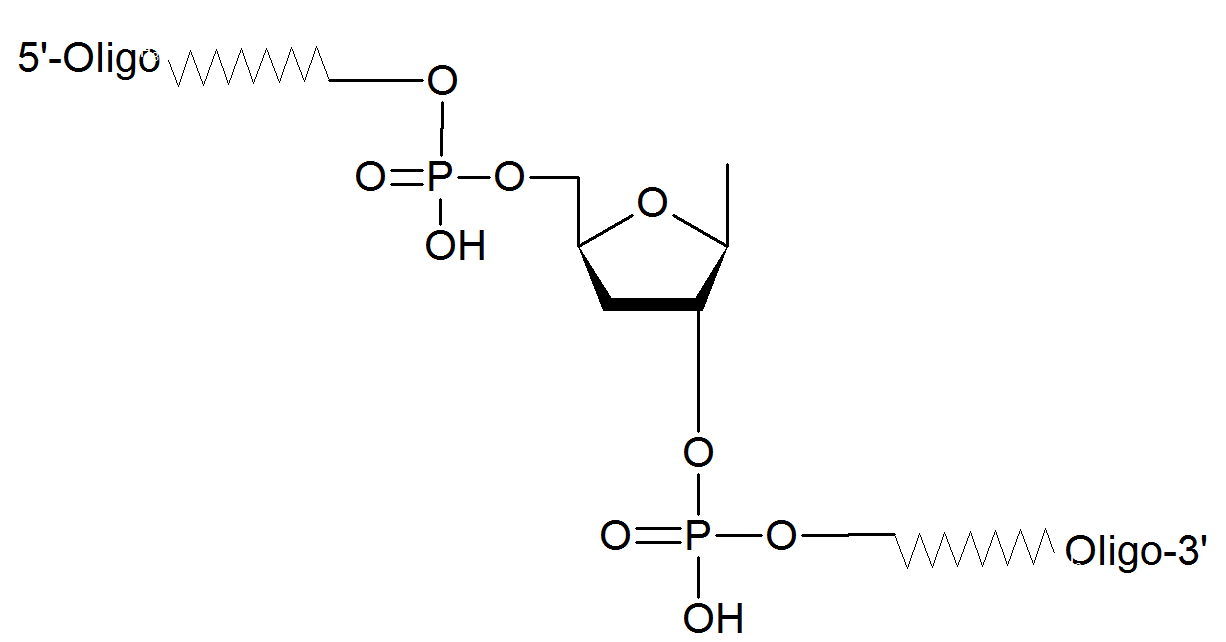
|
Increased binding efficiency
|
Increased
|
2'-5' phosphodiester linkages and 3' deoxy
|
|
Chimeric
|
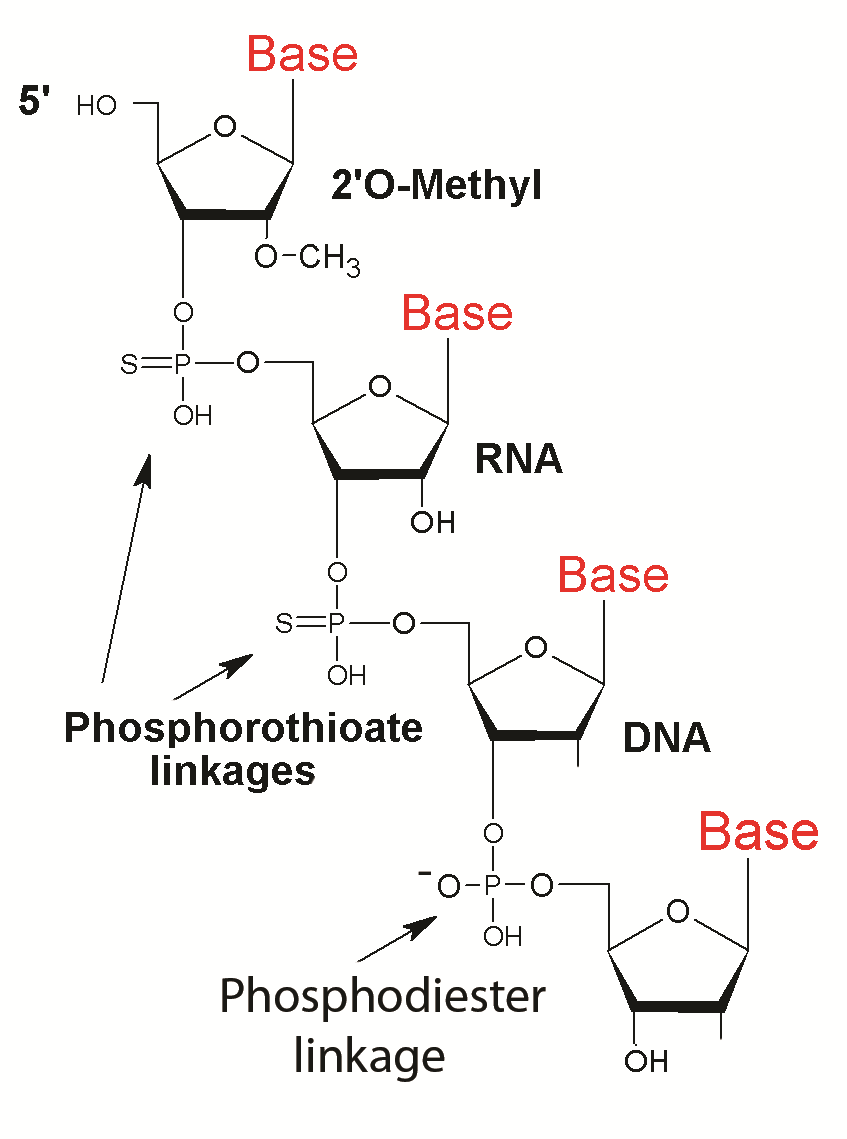
|
Substantially increased
|
Substantially increased
|
Properties based on modifications used.
|
Phosphorothioate
The driving force for the search for novel chemical modification groups compatible with Watson-Crick hybridization of oligonucleotide was based on the observation of the short stability of naturally occurring oligonucleotides with phosphodiester bonds. Oligonucleotides with natural phosphodiester bonds are highly susceptible to rapid degradation by cellular nucleases. Cellular nucleases have endonuclease activity as well such that 3' and 5' end caps are not sufficient to prevent from degradation.
Modifications of the phosphodiester bond by replacing one of the non-bridging oxygen by sulfur imparts resistance to nuclease degradation, but in general hybridize to the target sequences with lesser affinity than the phosphodiester counter part.
The sulfur-substituted oligonucleotides have a phosphorothioate linkage and are termed as phosphorothioates or simply as S-oligo. Phosphorothioate oligos are synthesized by Gene Link using the Beaucage sulfurizing reagent. The sulfurization reaction is rapid and is performed on automated DNA synthesizers yielding greater than 96% phosphorothioate linkages; the remainders are phosphodiester linkages. Custom phosphorothioate oligonucleotides synthesized by Gene Link can be specified to have all the diester bonds substituted or only some selected diester linkages depending upon the researcher's experimental requirement. Substitution of all diester linkage is recommended to provide greater nuclease resistance.
The most common usage for oligonucleotide phosphorothioates has been in the production of antisense oligodeoxynucleotides destined for use in identifying or modifying gene expression. Now, phosphorothioate linkages are popping up in the RNA world and sulfurizing RNA linkages with reagents like Beaucage Reagent has proved to be much more difficult than DNA linkages. The phosphorothioate (PS) linkage is a not-so-expensive way of increasing the stability of nucleic acids and increasing nuclease resistance of RNA. It has been shown that fully PS oligos can promote the delivery of siRNA in cell culture. This siRNA uptake is sequence-independent and the length seems to vary between 30 and 70 nucleotides depending on the cell line. Even though this method is not yet as efficient as the cationic lipids, it opens the way to possible new methods. Reasons that may explain this are not understood at this time.
A method for the inactivation of micro RNA (miRNA) that may help to elucidate their functions has been described, it uses 2'-OMe-RNA oligonucleotides (23-mers, complementary to a target miRNA) with a cholesteryl group at the 3' terminus and phosphorothioates at positions 1 and 2 at the 5' end and at the last four positions at the 3' end. These oligos are called antagomirs. These molecules promote the cleavage of complementary miRNAs and thus should allow analysis of their function. The role of the PS linkages presumably is the stabilization against degradation in the mouse experiments as it is standard in the antisense field in such in vivo situations. And finally, a recent paper shows that PS does not systematically abolish siRNA activity, opening the way for some potentially less expensive stabilization of such molecules. Incorporation of 2'-OMe (in the sense strand) in combination with PS linkages should confer to siRNA increased resistance to degradation by nucleases, as well as prolonged serum retention. And it is also possible that such easy modification of siRNA may increase the specificity by eliminating sense strand recruitment in the RISC complex and thus reducing a source of off-target effect.
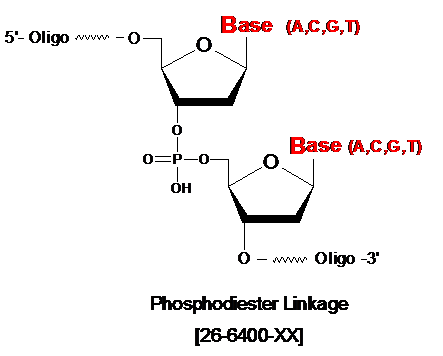
|
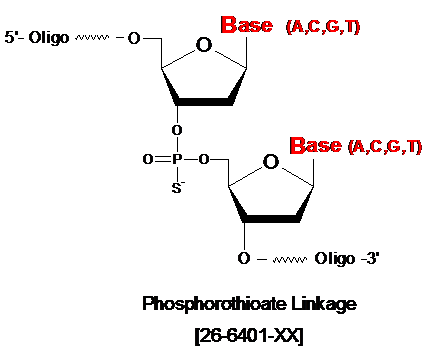
|
|
Phosphodiester Linkage
|
Phosphorothioate Linkage
|
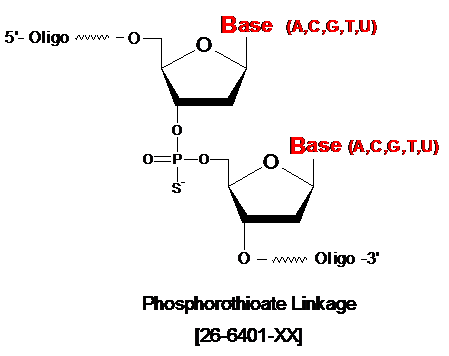
|
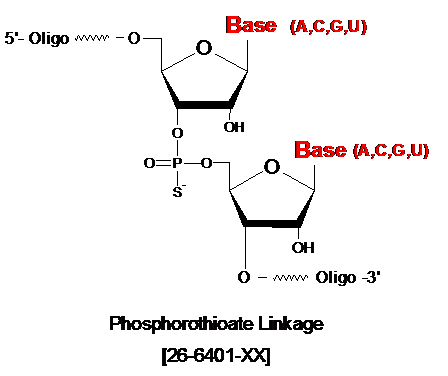
|
|
Chimeric Phosphorothioate Linkage
|
RNA Phosphorothioate Linkage
|
Propyne* Analogs
It has been shown that C-5 propyne analogs of dC and dT when substituted in phosphorothioate oligonucleotide imparts greater inhibition of gene expression due to increased binding affinity to the target mRNA and increased stability (5). Based on the above information antisense oligonucleotide could either be Phosphorothioated at all diester linkages or combined with substitutions of dC and dT by C-5 propyne analogs pdC and pdU.
The use of propyne analogs is covered by patents and licensing agreements. The sale of propyne-modified oligos is for research use only. See license agreement*
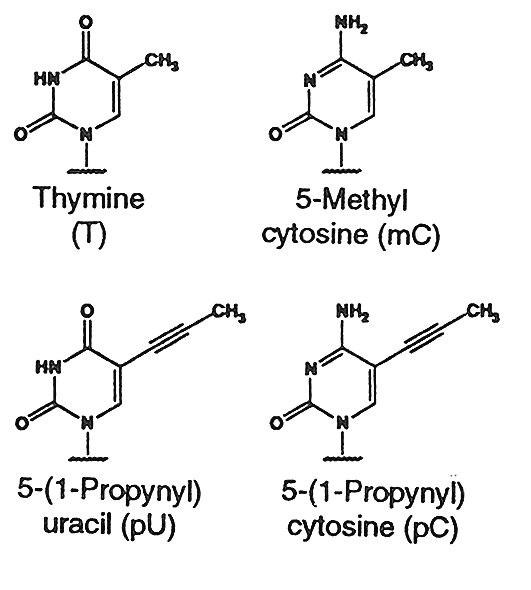
|
|
Propyne Analogs
|
2'-O-methyl RNA oligonucleotides
RNA oligos are susceptible to degradation to the same extent as native RNA extracted from various sources. An attractive alternate to prevent degradation from nucleases is the use of 2'-O- methyl RNA bases, when specific 2' OH is not required. The 2'-O- methyl oligonucleotides confer considerable nuclease resistance and are similar in hydrogen bonding properties to RNA/RNA than the lower RNA/DNA binding property (7). The coupling efficiency of 2'-O- methyl phosphoramidite is also higher than the RNA monomers resulting in higher yield of full-length oligos.
Gene Link also offers custom synthesis of RNA and DNA chimeric oligos with investigator specified ribo or deoxy bases or 2'-O-methyl bases.
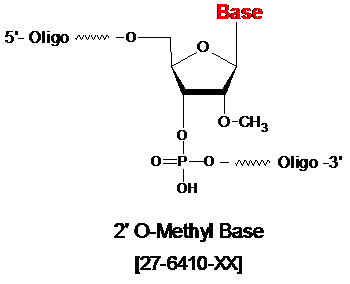
|
|
2'0-methyl base
|
2'-5' Linked Oligonucleotides
Cellular DNA and RNA are made up of ribo- and 2'-deoxyribonucleic acids linked together via 3'-5' phosphodiester linkages and by far comprise the bulk of polynucleic acids found in cells. Much less common are oligonucleotides which have 2'-5' linkages. However, a unique feature of 2'-5' linked oligonucleotides is their ability to bind selectively to complementary RNA (12-13). These features suggest a number of interesting uses for 2'-5' linked oligos such as their use as RNA specific probes or in antisense oligos.
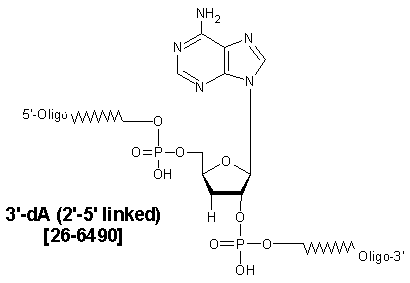
|
|
2'-5' Linked Oligonucleotides
|
2-Amino-dA & 5-Me-dC
The underlying principle of genetic molecular interaction is Watson and Crick base pairing. Consistent efforts have been expended to introduce different modifications to the bases to increase duplex stability in turn making the hybridization stronger. Two such modifications are discussed below that can be easily substituted in almost all primer, oligo, probe and antisense oligonucleotide design.
As shown in Figure below, A-T base pairs have two hydrogen bonds whereas G-C base pairs have three hydrogen bonds. The simplest approach to improving primers would be to substitute A sites with 2-amino-A which forms three hydrogen bonds with T on hybridization. 2-Amino-A also destabilizes A-G wobble mismatches, thus increasing specificity.
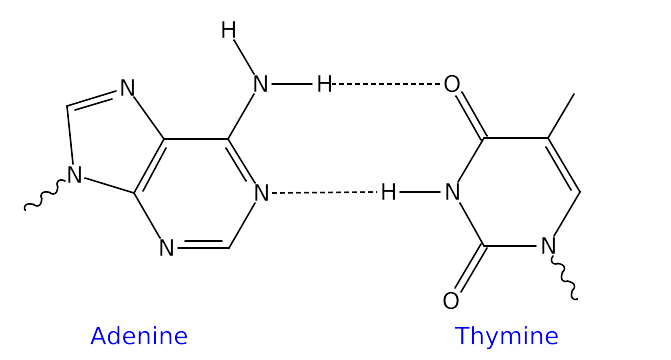
|
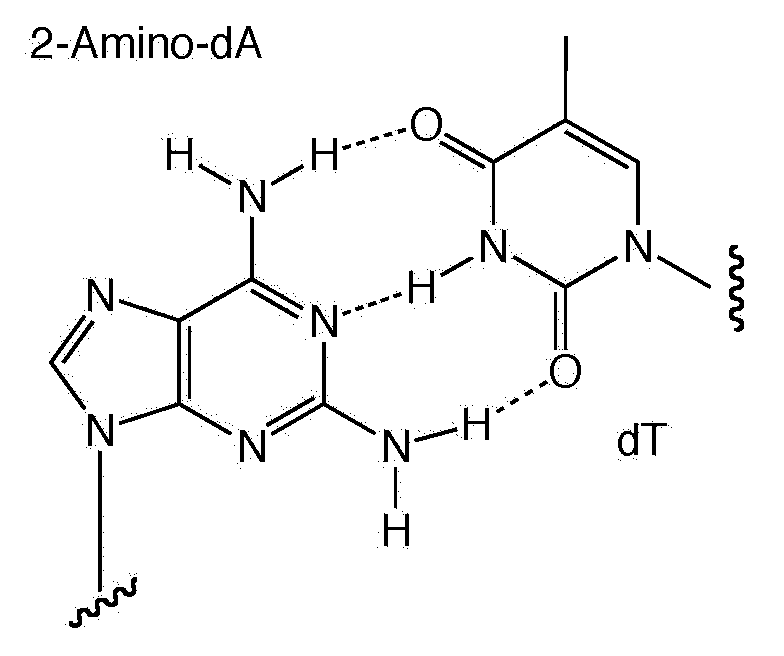
|
|
A-T Base Pairing
|
2-Amino dA-dT Base Pairing
|
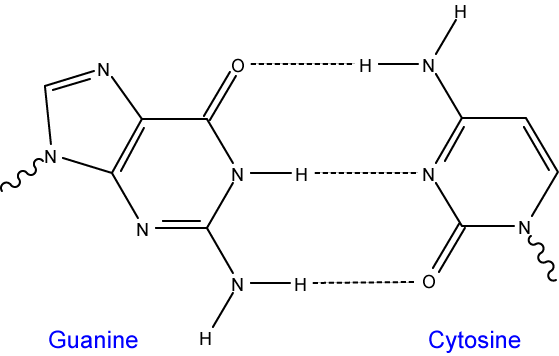
|
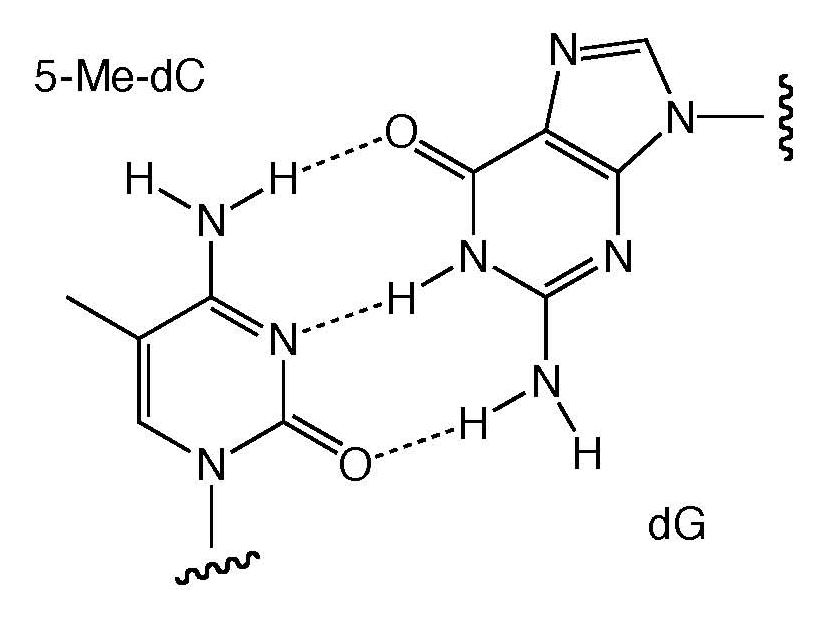
|
|
G-C Base Pairing
|
5-Me-dC-dG Base Pairing
|
|
2-Amino dA & 5-Methyl dC Duplex Stability and Nuclease Resistance
|
|
Modification
|
Duplex Stability [Tm Increase]
|
Nuclease Resistance
|
|
2-Amino-dA
|
Increased [3.0o per substitution]
|
No effect
|
|
5-Methyl-dC
|
Increased [1.3o per substitution]
|
No effect
|
2'-F-RNA Monomer
2'-Deoxy-2'-fluoro-nucleosides adopt an RNA-type sugar conformation, presumably due to the high electronegativity of fluorine. Because of this sugar conformation, RNA duplexes (A-form) are generally more thermodynamically stable than DNA duplexes (B-form). As expected, the addition of 2'-F-RNA residues to oligodeoxynucleotides progressively increases the thermal stability of their duplexes with RNA. The stabilization is additive at approximately 2o per residue. This compares favorably with 2'-OMe-RNA at around 1.5o and RNA at 1.1o per residue. In the meantime, base pair specificity remains intact.
2'-F-RNA phosphodiester linkages are not nuclease resistant, although the corresponding phosphorothioate linkages are highly resistant. Researchers usually design antisense oligonucleotides to form duplexes with RNA, which are then substrates for RNase H. Uniformly modified 2'-F-RNA/RNA duplexes are not substrates for RNase H. However, it is straightforward to prepare chimeric 2'-F-RNA/DNA phosphorothioate oligonucleotides which exhibit enhanced binding to the RNA target, are substrates for RNase H, and are highly nuclease resistant.
Fluorine has an interesting combination of properties, combining electro negativity similar to a hydroxyl group with size between oxygen and a hydrogen atom. This combination leads to the ring of a 2'-F-ribonucleoside adopting a C3'-endo conformation and the resulting 2'-F-RNA oligonucleotide adopts an A-form helix on hybridization to a target. Indeed, circular dichroism (CD) spectra of 2'-F-RNA/RNA duplexes indicate that they are A-form and that the sugars have all adopted the C3'-endo pucker. An important difference between RNA and 2'-F-RNA is that a hydroxyl group is a hydrogen bond donor while fluorine is a weak acceptor.
In studying antisense oligonucleotides, a group at Isis Pharmaceuticals concluded that oligonucleotides hybridized to a target RNA oligonucleotide in the following order of increasing stability: DNA < RNA < 2'-OMe-RNA < 2'-F-RNA. With an RNA target, melting temperature (Tm) was enhanced relative to an antisense DNA oligonucleotide by 1o C per residue for RNA, 1.3 o C for 2'-OMe-RNA, and 1.8 o C for 2'-F-RNA. The stability enhancement for 2'-F-RNA hybridizing to an RNA target was additive for each 2'-F-RNA residue and slightly cooperative i.e., the delta Tm per substitution increases as more 2'-F-RNA residues are incorporated into the oligonucleotide. This has led to the use of 2'F-RNA in aptamers since the resulting aptamers are not only more resistant to nucleases compared to 2'-OH RNA aptamers, but also bind ligands with higher affinities. The use, however, of 2'-F-RNA in antisense applications is limited since the 2'-F-RNA exhibits little enhanced nuclease resistance compared to DNA and its hybrid duplex does not activate RNase-H.
|
2'-Fluoro RNA Oligonucleotide
|

|

|

|

|
It has been demonstrated that siRNA synthesized with 2'-F pyrimidines showed greatly increased stability in human plasma compared to 2'-OH siRNA. They were functional in cell culture and in vivo using BALB/c mice transfected with pGL3 luciferase. Interestingly, though the 2'-F siRNA was significantly more stable than 2'-OH siRNA, they were only slightly more inhibitory over time in cell culture than 2'-OH siRNA; in vivo, their activities were practically the same. The authors note that these results may depend upon the siRNA delivery methodology.
Less has been reported on the stability of duplexes between 2'-F-RNA and DNA. The cleavage of RNA/DNA duplexes by RNase H, 2'-F-Adenosine (2'-F-A) oligonucleotides and chimeras containing 2'-F-A and rA were used to evaluate the ability of the modified RNA strand to promote varying levels of RNase-H activity. The authors measured the Tm of 18-mer oligonucleotides containing rA and/or 2'-F-A to oligo-T18 and found that the homopolymer of 2'-F-A enhanced binding by 0.5o per residue relative to rA. However, chimeras of 2'-F-RNA and rA were unpredictable in their melting behavior and some actually lowered the duplex Tm.
Glen Research melting experiments of duplexes containing 2'-F-RNA supported these results. They found that a single substitution of 2'-F-RNA in a mixed base DNA/DNA dodecamer increased the Tm by 1.2 o C. However, further substitutions with two or four 2'-F-RNA residues led to a drop in the Tm by 1.3 o C. Interestingly, a fully substituted 2'-F-RNA/DNA duplex does exhibit higher stability, with the Tm being increased by 0.5o per incorporation.
Pyrimidine Analogues
C-5 methyl pyrimidine nucleosides are known to stabilize duplexes relative to the non-methylated bases. Therefore, enhanced binding can be achieved using 5-methyl-dC in place of dC, duplex melting temperature being increased by 1.3o . Improved stacking in this case is believed to be brought about by elimination of water molecules from the duplex. 2,6-Diaminopurine 2'-deoxyriboside (2-amino-dA) forms an additional hydrogen bond with Thymidine, thereby leading to duplex stabilization with a melting temperature increase of 3o .
|
